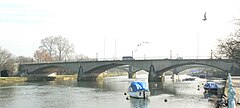Twickenham Bridge: Difference between revisions
Created page with "{{Infobox bridge |county 1=Middlesex |county 2=Surrey |picture=Twickenham Bridge 320r1.jpg |carries=A316 road |crosses=River Thames |architect=Maxwell Ayrton |built=1933 |..." |
m →top: ioe -> nhle, replaced: {{IoE|436133 → {{NHLE|1253011 |
||
| (One intermediate revision by one other user not shown) | |||
| Line 12: | Line 12: | ||
|longitude=-0.314444 | |longitude=-0.314444 | ||
}} | }} | ||
'''Twickenham Bridge''' crosses the [[River Thames]] between [[Twickenham]] in [[Middlesex]] and [[Richmond]] in [[Surrey]]. Built in 1933 as part of the newly constructed "Chertsey Arterial Road", the bridge connects the Old Deer Park district of Richmond on the south bank of the river to St Margarets on the north bank. Twickenham Bridge gets its name from the fact that it is on the road to the town of [[Twickenham]], which is approximately two miles upstream from Twickenham Bridge, past [[Richmond Bridge]]. | '''Twickenham Bridge''' crosses the [[River Thames]] between [[Twickenham]] in [[Middlesex]] and [[Richmond, Surrey|Richmond]] in [[Surrey]]. Built in 1933 as part of the newly constructed "Chertsey Arterial Road", the bridge connects the Old Deer Park district of Richmond on the south bank of the river to St Margarets on the north bank. Twickenham Bridge gets its name from the fact that it is on the road to the town of [[Twickenham]], which is approximately two miles upstream from Twickenham Bridge, past [[Richmond Bridge]]. | ||
The bridge forms part of today's A316 (Chertsey Road), which links central and western London with the [[M3 motorway]] at [[Sunbury-on-Thames]]. | The bridge forms part of today's A316 (Chertsey Road), which links central and western London with the [[M3 motorway]] at [[Sunbury-on-Thames]]. | ||
| Line 24: | Line 24: | ||
In 1992, the first speed camera in the United Kingdom was launched on Twickenham Bridge.<ref>http://www.telegraph.co.uk/motoring/road-safety/9272478/Speed-cameras-20-years-on.html</ref> | In 1992, the first speed camera in the United Kingdom was launched on Twickenham Bridge.<ref>http://www.telegraph.co.uk/motoring/road-safety/9272478/Speed-cameras-20-years-on.html</ref> | ||
The bridge was declared a Grade II* listed structure in 2008, providing protection to preserve its special character from unsympathetic development.<ref>[http://news.bbc.co.uk/1/hi/england/london/7750180.stm ''London bridges get listed status ''] (BBC News) accessed 26 November 2008</ref><ref>{{ | The bridge was declared a Grade II* listed structure in 2008, providing protection to preserve its special character from unsympathetic development.<ref>[http://news.bbc.co.uk/1/hi/england/london/7750180.stm ''London bridges get listed status ''] (BBC News) accessed 26 November 2008</ref><ref>{{NHLE|1253011}} accessed 27 November 2008</ref> | ||
[[Image:Twickenham Bridge312-315b.jpg|thumb|250px|Twickenham Bridge – a panorama looking downstream]] | [[Image:Twickenham Bridge312-315b.jpg|thumb|250px|Twickenham Bridge – a panorama looking downstream]] | ||
Latest revision as of 10:51, 19 September 2019
| Twickenham Bridge | |
| Middlesex, Surrey | |
|---|---|

| |
| Location | |
| Carrying: | A316 road |
| Crossing: | River Thames |
| Location | |
| Location: | 51°27’38"N, 0°18’52"W |
| Structure | |
| No. of spans: | 3 |
| History | |
| Built 1933 | |
| Architect: | Maxwell Ayrton |
| Information | |
Twickenham Bridge crosses the River Thames between Twickenham in Middlesex and Richmond in Surrey. Built in 1933 as part of the newly constructed "Chertsey Arterial Road", the bridge connects the Old Deer Park district of Richmond on the south bank of the river to St Margarets on the north bank. Twickenham Bridge gets its name from the fact that it is on the road to the town of Twickenham, which is approximately two miles upstream from Twickenham Bridge, past Richmond Bridge.
The bridge forms part of today's A316 (Chertsey Road), which links central and western London with the M3 motorway at Sunbury-on-Thames.
The bridge's architect was Maxwell Ayrton and the head engineer was Alfred Dryland. The proposed design of the bridge envisaged four 70-foot towers to be constructed on the riverbanks with retaining walls of 20 feet above road level. The plans were widely opposed and a local petition was organised by the Daily Telegraph against the design on the grounds that it was inappropriate to the setting in Richmond.
The final design of the bridge was of three reinforced-concrete arches supported on concrete piers with Art Deco embellishments. The bridge incorporates three permanent hinges enabling the structure to adjust to changes in temperature, the first reinforced concrete bridge structure in the UK to use such an innovation.[1] The arch springings, as well as the arch crowns, have decorative bronze cover plates. Ribbed shuttering was used in the casting of the concrete piers and abutments, giving the main faces a ribbed finish that was then knocked back. The approach viaduct and retaining walls were constructed in precast blocks that were wire brushed to create a rough finish.[2] The balustrades and lamps were constructed of open bronzework. The Bromsgrove Guild was employed in casting and fitting the bronze lamp standards and parapets as well as the railings on the four staircases between road level and the river bank [3]
The bridge was opened on 3 July 1933 by Edward, Prince of Wales.
In 1992, the first speed camera in the United Kingdom was launched on Twickenham Bridge.[4]
The bridge was declared a Grade II* listed structure in 2008, providing protection to preserve its special character from unsympathetic development.[5][6]

References
- ↑ Twickenham Bridge at 75 – Transport for London accessed 5 July 2009
- ↑ Engineering timelines accessed 5 July 2009
- ↑ The Bromsgrove Guild - an Illustrated history
- ↑ http://www.telegraph.co.uk/motoring/road-safety/9272478/Speed-cameras-20-years-on.html
- ↑ London bridges get listed status (BBC News) accessed 26 November 2008
- ↑ National Heritage List 1253011: Twickenham Bridge accessed 27 November 2008